Gorgoneion | Mythical Amulet

Gorgoneion (ancient Greek Γοργόνειον) is the name given to the head cut off by Perseus of the Gorgon Medusa, therefore also called Gorgon's head or Medusa's head, which according to Greek myth Athena placed in the center of her Aigis as a petrifying fright image and as such wears on her shield.
As a magical protective and frightening agent (apotropaion), it decorates weapons of all kinds, chariots, ships, horse decorations, city walls, amulets, garments, furniture, sarcophagi, etc.
History of development
Historically, it can be proved that the original type, a demonic grimace face formed en face (mask-like) with outstretched tongue and boar's teeth, already occurs in Phoenician art (Besa type), was adopted by Greek artists not before the 7th century BC and was gradually reshaped.
Archaic type
In the archaic art there is actually only one type of the Gorgoneion, which admittedly has countless variants. Initially, the representation makes no or only little use of snakes, but apparently more often with a chin beard, and this also with undoubtedly female Gorgons in whole figure.
The oldest representations of this archaic type are found analogously in the striding winged Gorgon. Snakes as an attribute are missing in the oldest Gorgon representations, but they found their way in very quickly, and much more quickly and generally than they were connected with the grimace face to the Gorgoneion. First as a snake belt and with a snake in each hand.
Among the oldest preserved Gorgoneion probably belongs the Asia Minor Electron Stater, discovered during excavations at Parion, which is placed in the 7th century BC.
The essential features of the basic type are the broadly distorted mouth, which allows the teeth to be seen, the powerful chin cheeks, the outstretched tongue, the gawking, usually very large eyes and the more or less circular overall shape of the mask, from which usually only the chin protrudes somewhat at the bottom. As a rule, the canines are large like those of predators.
The hair (with isolated exceptions) is arranged smoothly around the forehead, either in curls or in wavy sections. Where the Gorgoneion appears in a round (thus in particular on coins and in the inside of bowls), there the indication of the hair is limited to those surrounding the forehead. Otherwise, however, wide hair braids tend to fall down at the sides. The ears are often decorated with circular earrings.
Medium type
Between the archaic (ugly) type and the later beautiful type, the middle type appears as a transition towards the middle of the 5th century BC. It is clearly less grotesque and threatening; everything that seems exaggerated is here toned down to a far less natural degree.
By this time, the Gorgon had lost its tusks, and the serpents were depicted in a more stylized fashion. It no longer appears quite as frequently as it did in the Archaic period, but it has also lost its tectonic, decorative character due to its transformation. It no longer covers large frontal bricks and shields.
If it appears on a shield, it no longer fills it completely, but only appears small in the center. It disappears from the interior of Attic bowls, becomes rarer on bronze toes, and the half figure no longer appears at all. On the other hand, the gorgoneion now has a more exclusive and definite relationship to Athena, which it did not have before, due to the Attic art that has come to dominate.
Beautiful type
While the previous type had significantly softened the grimacing, distorted appearance of the old, but still retained it in this moderate form, here it has completely disappeared. The last remnant of that broad distortion has disappeared from the mouth, and the face is of pure, flawless beauty.
Characterization is only by expression, by the formation of the hair, and often, but not always, by the addition of the serpents. We can distinguish two series within this type, which also followed each other historically. In one of them the face is quietly beautiful.
This type appears already towards the end of the 5th century (for example, the cut Medusa head in the hand of Perseus on the Attic vase belonging to the end of the 5th century Annali dell' Inst. 1881, tav. F, completely without distortion, smooth hair, without any external markings) and is particularly formed in the 4th.
But the new type went on for a long time alongside the middle one, still in use, until it gained dominance. Towards the end of the 4th century, wings were often added as a new element to the gorgoneion, which had already been connected to it in isolated cases in the 5th century.
The later art of the second series, whose (pathetic) type is formed in the 3rd century and has ruled since then, gives the wonderfully beautiful female face,
frozen in its death throes, pathetically distorted (Medusa Rondanini in the Munich Glyptothek see illustration; the relief of the so-called Ludovisian Medusa can only be regarded as the head of some dying heroine), whereby in place of the snakes flickering through the hair, the tangled fluttering hair itself finally appears. The wings are the rule here.
One more transformation of the Gorgoneion is to be mentioned - which belongs to the most imaginative creations of the Hellenic art - the transformation to a sea creature. The cold horror of the sea tide was the leading thought here. The eyes, large and round, resemble those of fish with their cold stare. All kinds of sea plants and animals are used on the face and in the hair.
